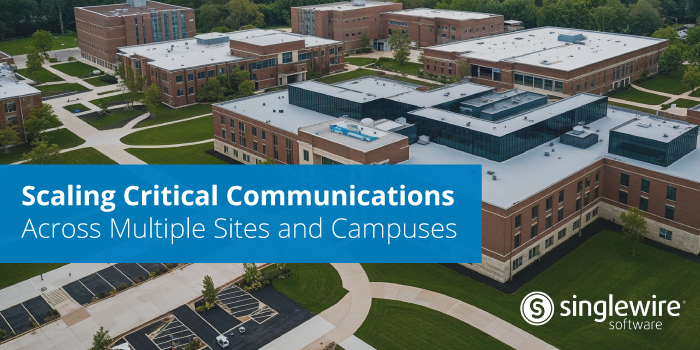Receiving the Right Information Regardless of Location
When emergencies happen, every second matters. But many organizations don’t operate out of just one building. Universities span multiple campuses. Healthcare systems include clinics, hospitals, and administrative offices spread across cities. Enterprises often manage regional hubs, satellite offices, and data centers. Even K-12 school districts are essentially small networks of independent facilities.
For safety leaders and facility managers, this creates a pressing challenge: how do you scale critical communications so everyone receives the right information—instantly—no matter where they are?
This blog explores why scaling critical communication systems matters, the challenges of managing dispersed facilities, and the strategies organizations can use to unify safety alerts across multiple sites.
Why Scaling Critical Communications Matters
Critical communications are the backbone of safety and continuity. They allow organizations to:
- Warn and protect people in danger. Whether it’s severe weather, workplace violence, or a hazardous spill, fast communication saves lives.
- Maintain operational stability. Alerts about IT outages, equipment failures, or facility closures keep disruptions from spreading.
- Build trust and confidence. Employees, students, and visitors feel safer when they know their organization can communicate quickly and clearly.
When these messages don’t reach people at every site, the consequences can be costly—ranging from confusion and productivity loss to reputational damage or, in the worst case, preventable harm.
The Challenges of Multi-Site Communication
Scaling critical communications across multiple facilities isn’t as simple as sending a group email. Facility managers and safety teams face unique obstacles:
1. Dispersed Technology Ecosystems
Each site may have its own paging systems, phone networks, or emergency protocols. Without integration, communication becomes siloed and inconsistent.
2. Varied Risk Profiles
Different sites face different threats. A downtown office may worry about civil unrest, while a suburban warehouse might prioritize weather alerts. Communication needs to adapt to local conditions while staying consistent across the organization.
3. Message Overload and Relevance
If every alert goes to everyone every time an issue occurs, people may begin to tune out. Employees in Chicago don’t need to know about a water leak in Dallas. Over-communication erodes trust just as much as under-communication.
4. Limited Facility Oversight
Facility managers can’t be everywhere at once. They need tools that give them visibility into whether messages are received and acted upon, across multiple sites.
Strategies for Scaling Critical Communications
So how can organizations overcome these challenges? Here are several proven strategies for building a scalable, reliable communication system across multiple sites and campuses.
1. Adopt a Unified Critical Communications Platform
The first step is moving away from piecemeal solutions. Instead of relying on site-by-site tools, organizations need a centralized platform that can:
- Push alerts across multiple channels (text, phone, email, digital signage, speakers).
- Segment messages by location, role, or risk type.
- Offer a single interface for facility managers and safety leaders to monitor and manage alerts.
A unified platform ensures consistent messaging and reduces the chance of communication blind spots.
2. Create Site-Specific Communication Profiles
Every site should have a communication profile that outlines:
- Primary and secondary risks.
- Preferred notification methods (e.g., PA speakers for manufacturing, desk phone alerts for corporate offices).
- Escalation procedures if a message isn’t acknowledged.
By tailoring communication to each facility’s needs, organizations ensure that messages are relevant and actionable.
3. Establish Multi-Tiered Alerting
Not every incident warrants the same level of communication. A well-structured system should include:
- Local alerts: Sent to people in a specific building or site.
- Regional alerts: Covering multiple facilities within a geographic area.
- Global alerts: Organization-wide messages for events that affect everyone, like cybersecurity incidents or corporate policy changes.
This prevents over-notification while ensuring the right people get the right information at the right time.
4. Integrate with Facility Infrastructure
Critical communications shouldn’t exist in a vacuum. Integration with physical and digital systems amplifies effectiveness. Examples include:
- Access control systems: Automatically locking doors during a threat.
- Environmental sensors: Triggering instant communication when thresholds are reached.
- Workplace tools: Embedding notifications into collaboration platforms like Microsoft Teams, Webex, or Slack.
These integrations streamline workflows and reduce reliance on manual intervention.
5. Test and Train Regularly
A scalable system only works if people know how to use it. Regular drills and communication tests across sites help:
- Identify gaps in message delivery.
- Familiarize staff with notification processes.
- Build confidence that the system will perform during real emergencies.
Facility managers should track drill results and continuously refine communication plans based on lessons learned.
6. Centralized Reporting and Analytics
Visibility is essential for facility managers overseeing multiple sites. Centralized dashboards and reporting tools provide:
- Real-time insight into who received and acknowledged alerts.
- Performance metrics for each site.
- Audit trails to demonstrate compliance with safety regulations.
Analytics turn communication from a reactive tool into a proactive safety strategy.
Implementing An Effective Strategy
Scaling critical communications across multiple sites and campuses isn’t just a technical challenge—it’s a strategic necessity. Without a unified approach, organizations risk leaving people unprotected, confused, or uninformed during emergencies.
For facility managers and safety leaders, the opportunity is clear: by building integrated, site-specific, and scalable communication systems, they can strengthen safety, enhance operational continuity, and lead their organizations with confidence.
To learn more about solutions that can help with organization-wide communication across multiple sites, visit our InformaCast page.
